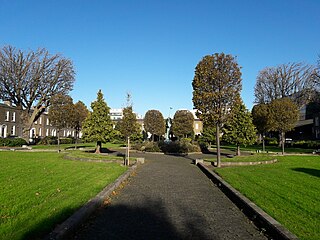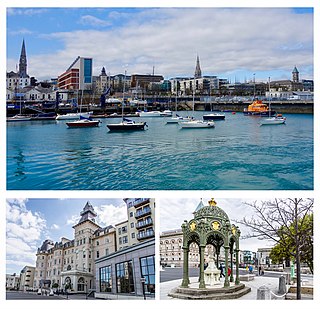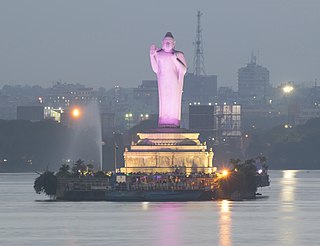
Glendalough is a glacial valley in County Wicklow, Ireland, renowned for an Early Medieval monastic settlement founded in the 6th century by St Kevin. From 1825 to 1957, the head of the Glendalough Valley was the site of a galena lead mine. Glendalough is also a recreational area for picnics, for walking along networks of maintained trails of varying difficulty, and also for rock climbing.

The Wicklow Mountains form the largest continuous upland area in Ireland. They occupy the whole centre of County Wicklow and stretch outside its borders into the counties of Dublin, Wexford and Carlow. Where the mountains extend into County Dublin, they are known locally as the Dublin Mountains. The highest peak is Lugnaquilla at 925 metres.

The Seokguram Grotto (Korean: 석굴암) is a hermitage and part of the Bulguksa temple complex in Gyeongju, South Korea. It and Bulguksa are both on the mountain Tohamsan, although the two are separated by distance of around 3 kilometres (1.9 mi). The grotto overlooks the East Sea and rests 750 meters above sea level. In 1962, it was designated the 24th National Treasure of South Korea. In 1995, Seokguram was added to the UNESCO World Heritage List together with the Bulguksa Temple. It exemplifies some of the best Buddhist sculptures in the world.

Kilmacanogue, officially Kilmacanoge, is a village in north County Wicklow, Ireland. It is southwest of Bray and is overlooked by Great Sugar Loaf mountain.

The Back Bay Fens, often simply referred to as "the Fens," is a parkland and urban wild in Boston, Massachusetts, United States. It was established in 1879. Designed by Frederick Law Olmsted to serve as a link in the Emerald Necklace park system, the Fens gives its name to the Fenway-Kenmore neighborhood.

Anna Vaughn Huntington was an American sculptor who was among New York City's most prominent sculptors in the early 20th century. At a time when very few women were successful artists, she had a thriving career. Hyatt Huntington exhibited often, traveled widely, received critical acclaim at home and abroad, and won multiple awards and commissions.

The Toluvila statue is a seated image of the Buddha discovered in 1900 in Anuradhapura, Sri Lanka, that dates back to the 4th or 5th century. Carved out of granite, it is one of the best-preserved sculptures from Sri Lanka and is similar to the Samadhi statue of Anuradhapura. Some features of the statue indicate that it may have been influenced by the Mathura School. The statue is now kept at the National Museum of Colombo.

Sculpture in the Indian subcontinent, partly because of the climate of the Indian subcontinent makes the long-term survival of organic materials difficult, essentially consists of sculpture of stone, metal or terracotta. It is clear there was a great deal of painting, and sculpture in wood and ivory, during these periods, but there are only a few survivals. The main Indian religions had all, after hesitant starts, developed the use of religious sculpture by around the start of the Common Era, and the use of stone was becoming increasingly widespread.

The National Capitol of Cuba, also known as Capitolio Nacional de La Habana, and often simply referred to as El Capitolio(The Capitol), is a public edifice in Havana, the capital of Cuba. The building was commissioned by Cuban president Gerardo Machado and built from 1926 to 1929 under the direction of Eugenio Rayneri Piedra. It is located on the Paseo del Prado, Dragones, Industria, and San José streets in the exact center of Havana.

Sofiyivsky Park is an arboretum and a scientific-researching institute of the National Academy of Sciences of Ukraine. The park is located in the northern part of the City of Uman, Cherkasy Oblast, near the Kamianka River. Some areas of the park are reminiscent of an English garden. Today, the park is a popular recreational spot, annually visited by 500,000 visitors.

Luggala, also called Fancy Mountain at 595 metres (1,952 ft), is the 230th-highest peak in Ireland on the Arderin scale. Being below 600 metres (2,000 ft), it does not rank on the Vandeleur-Lynam or Hewitt scales. Luggala is in the northeastern section of the Wicklow Mountains in Ireland, and overlooks the Lough Tay, which lies at the base of the steep granite cliffs on Luggala's eastern face. As well as a noted scenic point in County Wicklow, Luggala's eastern cliffs have many graded rock-climbing routes.

Powerscourt Estate, located in Enniskerry, County Wicklow, Ireland, is a large country estate which is noted for its house and landscaped gardens, today occupying 19 hectares. The house, originally a 13th-century castle, was extensively altered during the 18th century by German architect Richard Cassels, starting in 1731 and finishing in 1741. A fire in 1974 left the house lying as a shell until it was renovated in 1996.
Balally, County Dublin, Ireland, is a townland and residential area between Dundrum village and the Sandyford Industrial Estate in Sandyford.

Michelangelo's David have been made replicas for numerous times, in plaster, imitation marble, fibreglass, snow, and other materials. There are many full-sized replicas of the statue around the world, perhaps the most prominent being the one in the original's position in the Piazza della Signoria in Florence, Italy, placed there in 1910. The original sculpture was moved indoors in 1873 to the Accademia Gallery in Florence, where it attracts many visitors. Others were made for study at art academies in the late nineteenth century and later, while the statue has also been replicated for various commercial reasons or as artistic statements in their own right. Smaller replicas are often considered kitsch.

Pearse Square is a Georgian garden square in Dublin, Ireland. It is bounded on its southern side by Pearse Street.

Dún Laoghaire is a suburban coastal town in County Dublin in Ireland. It is the administrative centre of the county of Dún Laoghaire–Rathdown. The town was built up alongside a small existing settlement following 1816 legislation that allowed the building of a major port to serve Dublin. It was known as Dunleary until it was renamed Kingstown in honour of King George IV's 1821 visit, and in 1920 was given its present name, the original Irish form from which "Dunleary" was anglicised. Over time, the town became a residential location, a seaside resort, the terminus of Ireland's first railway and the administrative centre of the former borough of Dún Laoghaire, and from 1994, of the county of Dún Laoghaire–Rathdown.

The Buddha Statue of Hyderabad is a monolith located in India. It is the world's tallest monolith of Gautama Buddha, erected on Gibraltar Rock in the middle of Hussain Sagar.

East Sheen Cemetery, originally known as Barnes Cemetery, is a cemetery on Sheen Road in East Sheen in the London Borough of Richmond upon Thames, England. The cemetery opened in 1906 on what was previously woodland in a rural area of Surrey. Originally, only half the site was given over for burials while the other half was maintained as a nursery before it was converted in the 1930s and the whole site was renamed East Sheen Cemetery. It is today contiguous with Richmond Cemetery, though the original boundary is marked by a hedge. The cemetery's chapel is used for services by both sites, as Richmond Cemetery's chapel is no longer in use as such. The chapel was built in 1906 in the Gothic revival style by local architect Reginald Rowell, who was himself later buried in the cemetery.

Glendalough Upper Lake is a glacial lake near Glendalough, County Wicklow, Ireland.























